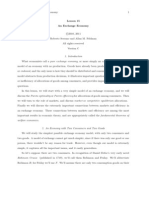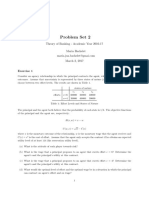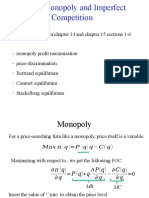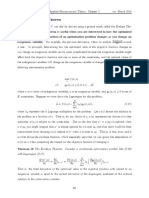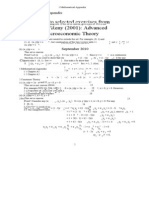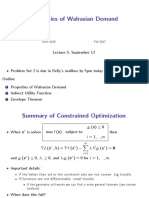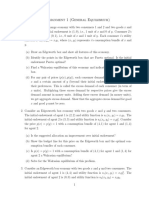Ps 1
Ps 1
Uploaded by
boja-bojaCopyright:
Available Formats
Ps 1
Ps 1
Uploaded by
boja-bojaOriginal Description:
Original Title
Copyright
Available Formats
Share this document
Did you find this document useful?
Is this content inappropriate?
Copyright:
Available Formats
Ps 1
Ps 1
Uploaded by
boja-bojaCopyright:
Available Formats
Microeconomics II Problem Set 1
Rules: You are strongly encouraged to work in groups of 3-4 people, but everyone has to hand in his or her own solution. Please write the names of other members of your group on your solution. Keep answers rigorous but brief and to the point. A subset of problems will be chosen randomly for grading and your score from the problem set will depend on the graded problems. Problem 1: Consider an economy with two consumers, two rms, and two commodities: time and the consumption good. Each consumer is endowed with 24 hours of time and has preferences over consumption (x1 ) and leisure (x2 ) given by the utility function 1/3 2/3 1 1 2/3 2 2 1/3 u1 (x1 (x1 for consumer 1 and u2 (x2 (x2 for consumer 2. 1 , x2 ) = (x1 ) 2) 1 , x2 ) = (x1 ) 2) Each rm produces the consumption good (y1 ) out of labor (y2 ) using the production 2 1 1 2 y2 0 for rm 1 and y1 0 for rm 2 y2 possibility set characterized by y1 2. Each consumer holds a one half share of each rm. Find the competitive equilibrium real wage rate, consumption bundles and production plans.
a Problem 2: Consider a two-consumer (a and b) and two-good economy. Let ua (xa 1 , x2 ) = 1/3 a 2/3 b b 1/3 b 2/3 (xa (x2 ) , a = (3, 1), ub (xb (x2 ) and b = (1, 1). Take good one as 1) 1 , x2 ) = (x1 ) the numeraire.
(a) Find the competitive equilibria. Graph then in the Edgeworth box. (b) Find the set of Pareto ecient allocations. Graph it in the Edgeworth box. Problem 3: Consider a 4-consumer, 2-good exchange economy. The consumers are labelled a, b, c, and d, and the goods are labelled x and y . Suppose that the utility functions and the initial endowments of consumers are as follows: ua (xa , y a ) = xa ub (xb , y b ) = y b u c ( xc , y c ) = xc y c d d ud (xd , y d ) = ex y a = (0, 1), b = (1, 0), c = (0, 1), d = (2, 0).
(a) Find the competitive equilibrium. (Assume that px = 1.) (b) Find the set of all Pareto-ecient allocations. Problem 4: Consider the following exchange economy: There are two agents a and b and two goods x and y . Agent as utility function is ua (xa , y a ) = min{xa (y a )2 , (xa )2 y a } and his initial endowment is (12, 0). Agent bs utility function is ub (xb , y b ) = xb y b , where > 0 and her initial endowment is (0, 12). (a) Suppose = 3. Find the competitive equilibria of this exchange economy. (Normalize the price of good x to 1.) (b) Suppose = 1. Find the competitive equilibria of this exchange economy. (Normalize the price of good x to 1.) (c) For a range of , the set of Pareto ecient allocations is the diagonal of the Edgeworth box. What is this range? Explain your answer. 1
Problem 5: Consider an exchange economy with I + 1 consumers and L goods. Let i i (1 , .., L ) denote consumer is initial endowment vector and ui denote his utility function. Suppose (x, p) is a competitive equilibrium of this economy, where x = (x1 , .., xI , I +1 ). That is, consumer I + 1 consumes his initial endowment I +1 at the competitive equilibrium. Now consider the situation when consumer I + 1 does not show up in the market. That is, consider the I -person exchange economy where the agents i = 1, .., I have the same initial endowment i and the utility function ui as before. Is the allocation (x1 , .., xI ) a competitive equilibrium allocation of this economy? Problem 6: Consider an economy composed of 2I + 1 consumers. Of these, I each own one right shoe and I + 1 each own a left shoe. Shoes are indivisible. Everyone has the same utility function given by min{L, R}, where L and R are the quantities of left and right shoes consumed, respectively. Free disposal is not allowed. (a) Show that any allocation of shoes that is matched (i.e., every individual consumes the same number of each kind) with the exception of one consumer who is consuming the remaining left shoe is Pareto ecient and conversely. (b) Let pL and pR be the respective prices of the two kinds of shoes. Find the competitive equilibria of this economy.
You might also like
- Problem Set #1. Due Sept. 9 2020.: MAE 501 - Fall 2020. Luc Deike, Anastasia Bizyaeva, Jiarong Wu September 2, 2020Document3 pagesProblem Set #1. Due Sept. 9 2020.: MAE 501 - Fall 2020. Luc Deike, Anastasia Bizyaeva, Jiarong Wu September 2, 2020Francisco SáenzNo ratings yet
- MOA - Fernando JewellersDocument3 pagesMOA - Fernando JewellersAga Fatrick100% (1)
- Case No. 9 Laying Out Arnold Palmer Hospital's New FacilityDocument2 pagesCase No. 9 Laying Out Arnold Palmer Hospital's New Facilityfer cagsNo ratings yet
- Regular Exam Jan - SolsDocument3 pagesRegular Exam Jan - SolsErmita YusidaNo ratings yet
- EC2101 Practice Problems 10 SolutionDocument3 pagesEC2101 Practice Problems 10 Solutiongravity_coreNo ratings yet
- Harvard Economics 2020a Problem Set 4Document4 pagesHarvard Economics 2020a Problem Set 4J100% (1)
- 2014 - Lectures Notes On Game Theory - WIlliam H SandholmDocument167 pages2014 - Lectures Notes On Game Theory - WIlliam H SandholmDiego Velasquez ZuñigaNo ratings yet
- Romania Adera La UCC 1988Document8 pagesRomania Adera La UCC 1988Atlanth ManNo ratings yet
- Anarcho Autism Anarchist Communism and Autism Acceptance Riley OlsonDocument119 pagesAnarcho Autism Anarchist Communism and Autism Acceptance Riley OlsonjustaguynlacamoiNo ratings yet
- 2011 Micro Homework3 PDFDocument4 pages2011 Micro Homework3 PDFEdmund Zin100% (1)
- EC411 Weakly ProblemsDocument13 pagesEC411 Weakly ProblemsAvijit PuriNo ratings yet
- Walrasian ExercisesDocument6 pagesWalrasian Exercisesvincus27No ratings yet
- Notes On Choice Under UncertaintyDocument8 pagesNotes On Choice Under UncertaintyJosé Daniel Fernández DávilaNo ratings yet
- Qdoc - Tips - Advanced-Microeconomics-Analysis-Worked-Solutions - 3333 PDFDocument7 pagesQdoc - Tips - Advanced-Microeconomics-Analysis-Worked-Solutions - 3333 PDFMarwan El SolhNo ratings yet
- CES Prodn FNDocument4 pagesCES Prodn FNspmisraNo ratings yet
- Lesson15PlusGraphs-An Exchange EconomyDocument36 pagesLesson15PlusGraphs-An Exchange Economyamrith vardhanNo ratings yet
- Pset6 Solutions HandoutDocument10 pagesPset6 Solutions HandoutthemiykNo ratings yet
- EconomicsDocument247 pagesEconomicsapi-3825259100% (1)
- Examination Advanced Microeconomics (ECH 32306) : InstructionsDocument2 pagesExamination Advanced Microeconomics (ECH 32306) : InstructionsHector CupperNo ratings yet
- Mat061 Module 4Document16 pagesMat061 Module 4Kert IbañezNo ratings yet
- API 111 Solutions 2Document12 pagesAPI 111 Solutions 2Anonymous L7XrxpeI1zNo ratings yet
- Micro Prelim SolutionsDocument32 pagesMicro Prelim SolutionsMegan JohnstonNo ratings yet
- MidtermODE (2013)Document8 pagesMidtermODE (2013)osw2002No ratings yet
- Hoel-1978 MonopolyDocument10 pagesHoel-1978 Monopolyoussamajemix555No ratings yet
- Oligopoly: Navigation Search Market Form Market Industry Monopoly Greek Strategic PlanningDocument9 pagesOligopoly: Navigation Search Market Form Market Industry Monopoly Greek Strategic PlanningJagan DassNo ratings yet
- Lecture 18Document20 pagesLecture 18praneixNo ratings yet
- Oligopoly, GameDocument35 pagesOligopoly, GameJoseph SubhaNo ratings yet
- Lecture Notes Microeconomic Theory, JehleDocument469 pagesLecture Notes Microeconomic Theory, Jehle胡卉然100% (1)
- Solution Exercises 2011 PartIDocument27 pagesSolution Exercises 2011 PartIcecch001100% (1)
- From Binomial Trees To The Black-Scholes Option Pricing FormulasDocument6 pagesFrom Binomial Trees To The Black-Scholes Option Pricing FormulasowltbigNo ratings yet
- General Equilibrium PDFDocument42 pagesGeneral Equilibrium PDFArchana RajNo ratings yet
- Week 2 SolutionsDocument6 pagesWeek 2 SolutionsAnton BochkovNo ratings yet
- Chapter 17 Oligopolies Look For The Answers To These QuestionsDocument24 pagesChapter 17 Oligopolies Look For The Answers To These QuestionsshamsaNo ratings yet
- ECON-602 Problem Set 2 - SolutionsDocument5 pagesECON-602 Problem Set 2 - SolutionszedisdedNo ratings yet
- Lecture Notes: Oligopoly: Intermediate MicroeconomicsDocument6 pagesLecture Notes: Oligopoly: Intermediate MicroeconomicsamenNo ratings yet
- Problem Set 2: Theory of Banking - Academic Year 2016-17Document5 pagesProblem Set 2: Theory of Banking - Academic Year 2016-17thanhpham0505No ratings yet
- Unit9 F22Document26 pagesUnit9 F22Julia SNo ratings yet
- Advanced Microeconomics: Envelope TheoremDocument3 pagesAdvanced Microeconomics: Envelope TheoremTianxu ZhuNo ratings yet
- MicroeconomicsDocument35 pagesMicroeconomicsRaghu Ram100% (1)
- EC2066Document49 pagesEC2066Josiah KhorNo ratings yet
- Microeconomie Livre Micro de Jehly SolutionnaireDocument33 pagesMicroeconomie Livre Micro de Jehly Solutionnaireramcesse89No ratings yet
- Description: ὀλίγος (olígos) "few" + πωλεῖν (poleîn) "to sell") isDocument16 pagesDescription: ὀλίγος (olígos) "few" + πωλεῖν (poleîn) "to sell") isJhonabie Suligan CadeliñaNo ratings yet
- Transcendental Logarithmic Cost Function: C Q Q W W W QWDocument7 pagesTranscendental Logarithmic Cost Function: C Q Q W W W QWLefteris SidiropoulosNo ratings yet
- Department of Economics: ECO 204 Microeconomic Theory For Commerce 2013 - 2014 Test 1 SolutionsDocument32 pagesDepartment of Economics: ECO 204 Microeconomic Theory For Commerce 2013 - 2014 Test 1 SolutionsexamkillerNo ratings yet
- Ps7 SolutionDocument6 pagesPs7 SolutionRagini ChaurasiaNo ratings yet
- Een 686: Optimal Control Sheet 03Document3 pagesEen 686: Optimal Control Sheet 03Do yggffNo ratings yet
- Solution To Mathematics For Economists Third EditionDocument67 pagesSolution To Mathematics For Economists Third EditionDoan HungNo ratings yet
- Lecture - 05 Properties of Walrasian DemandDocument22 pagesLecture - 05 Properties of Walrasian DemandAhmed GoudaNo ratings yet
- Oligopoly: Interdependence of Various Firms: No Player Can Take A Decision Without ConsideringDocument11 pagesOligopoly: Interdependence of Various Firms: No Player Can Take A Decision Without ConsideringDipendra Kumar ShahNo ratings yet
- Fundamental Theorem of Welfare EconomicsDocument8 pagesFundamental Theorem of Welfare EconomicsvincentljzNo ratings yet
- Notes On Microeconomic Thoery (Nolan H. Miller) IDocument127 pagesNotes On Microeconomic Thoery (Nolan H. Miller) IDavid A. BarrazaNo ratings yet
- Solutions To Problem Set 2: U U Is The Gradient of UDocument15 pagesSolutions To Problem Set 2: U U Is The Gradient of UWaqas Ahmad AwanNo ratings yet
- PS1 Solutions PDFDocument3 pagesPS1 Solutions PDFpcr123100% (1)
- Welfare TheoremsDocument8 pagesWelfare TheoremsJesús M. VilleroNo ratings yet
- Chapter 17 - Oligopoly Principles of Economics, 7th Edition N. Gregory MankiwDocument17 pagesChapter 17 - Oligopoly Principles of Economics, 7th Edition N. Gregory MankiwGinev Andrya Lei SencioNo ratings yet
- Advanced Microeconomics Assignment 1Document9 pagesAdvanced Microeconomics Assignment 1Lechisa BekeleNo ratings yet
- Maximum Value Functions and The Envelope TheoremDocument10 pagesMaximum Value Functions and The Envelope TheoremS mukherjeeNo ratings yet
- Exam Prep for:: Introduction to Game Theory in Business and EconomicsFrom EverandExam Prep for:: Introduction to Game Theory in Business and EconomicsNo ratings yet
- Universidad Del Rosario - Facultad de Econom Ia Microeconom Ia III - 2017-IDocument6 pagesUniversidad Del Rosario - Facultad de Econom Ia Microeconom Ia III - 2017-IGrace Margarita Angulo Pico (Docente)No ratings yet
- U (X, Y) X + 154y: EC 501/zenginobuz Fall 2021Document3 pagesU (X, Y) X + 154y: EC 501/zenginobuz Fall 2021Tayhan OzenNo ratings yet
- MEC-001 ENG-D13 CompressedDocument6 pagesMEC-001 ENG-D13 CompressedTamash MajumdarNo ratings yet
- Econ2020a 14 ps05Document3 pagesEcon2020a 14 ps05samuelifamilyNo ratings yet
- 1 Assignment 1 (General Equilibrium) : I I I I I I IDocument2 pages1 Assignment 1 (General Equilibrium) : I I I I I I IAnindita DeyNo ratings yet
- ExcelWorkshop 0408 PivotTablesDocument28 pagesExcelWorkshop 0408 PivotTablesRenz Francis LimNo ratings yet
- EBGB ShrunkDocument11 pagesEBGB ShrunkNajmul HasanNo ratings yet
- 2x2 Production Economy HandoutDocument3 pages2x2 Production Economy Handoutboja-bojaNo ratings yet
- Math NotesDocument244 pagesMath Notesboja-bojaNo ratings yet
- Untitled 8jfjdjdnfuvhDocument6 pagesUntitled 8jfjdjdnfuvhJohn DavisNo ratings yet
- Case Set 1 Licensed Shubhomoy BanerjeeDocument8 pagesCase Set 1 Licensed Shubhomoy BanerjeeTamanna MalikNo ratings yet
- Gujarat Technological UniversityDocument1 pageGujarat Technological Universitywolf gamingNo ratings yet
- IQ160 Datasheet 0516 USDocument2 pagesIQ160 Datasheet 0516 UScarolusNo ratings yet
- MOQ Displays Pricelist Nov'18Document11 pagesMOQ Displays Pricelist Nov'18gem lihanshNo ratings yet
- Deryl C Zeleny 613-392-3449 42 Nichols Road, Nichols Road Quinte West ON CAN K0K 1HODocument3 pagesDeryl C Zeleny 613-392-3449 42 Nichols Road, Nichols Road Quinte West ON CAN K0K 1HOopptfiles100% (1)
- HUL Vs P&GDocument17 pagesHUL Vs P&GManvi GoyalNo ratings yet
- How To Make 400watt Brushless Mini Sumo - 7 Steps - InstructablesDocument11 pagesHow To Make 400watt Brushless Mini Sumo - 7 Steps - Instructablesa6fcstt10No ratings yet
- Financial Management Consultancy in Dubai, UAE, Abu DhabiDocument15 pagesFinancial Management Consultancy in Dubai, UAE, Abu DhabiAsad Abbas & Co.No ratings yet
- Chapter 1 Differing Perspectives On Quality - Revision1Document20 pagesChapter 1 Differing Perspectives On Quality - Revision1Moon2803No ratings yet
- SNZ Equiptment Catalogue 24 67.4 MB DigitalDocument92 pagesSNZ Equiptment Catalogue 24 67.4 MB DigitalBogdan CocaNo ratings yet
- SopDocument2 pagesSopPeeyushiRaghavNo ratings yet
- SAS#3-ACC104 With AnswerDocument6 pagesSAS#3-ACC104 With AnswerartificerrrrNo ratings yet
- EP - EngineDocument4 pagesEP - EngineAkhmad HasimNo ratings yet
- Navigation in The Enterprise Portal and Business PackagesDocument64 pagesNavigation in The Enterprise Portal and Business PackagesAnonymous 3ZvXNhYNo ratings yet
- Western Kentucky University Master of Business Administration Rank II or Rank I Business and Marketing Grades 5-12, ProgramDocument48 pagesWestern Kentucky University Master of Business Administration Rank II or Rank I Business and Marketing Grades 5-12, Programnitinvasu100% (1)
- Radiotherapy Your Questions AnsweredDocument28 pagesRadiotherapy Your Questions AnsweredNIDHI PANDEYNo ratings yet
- Himachal Pradesh Tourism Policy 2019Document51 pagesHimachal Pradesh Tourism Policy 2019Spaceworks IncubatoriumNo ratings yet
- Entry Test Preparation Material For NTSDocument12 pagesEntry Test Preparation Material For NTSGhulam Mustafa67% (3)
- Software Cost EstimationDocument4 pagesSoftware Cost EstimationvenkatvavilalaNo ratings yet
- IoTES IIDocument112 pagesIoTES IISamiksha PawarNo ratings yet
- Composting For Sustainable AgricultureDocument295 pagesComposting For Sustainable AgricultureAli Mariouni Alawie100% (2)
- Belt Conveyor PulleysDocument24 pagesBelt Conveyor PulleysPercy Torres100% (4)
- KOLOMDocument1 pageKOLOMANDIKA REZKY E. SembiringNo ratings yet
- Subaru ManualDocument12 pagesSubaru ManualRoger Sego100% (2)















